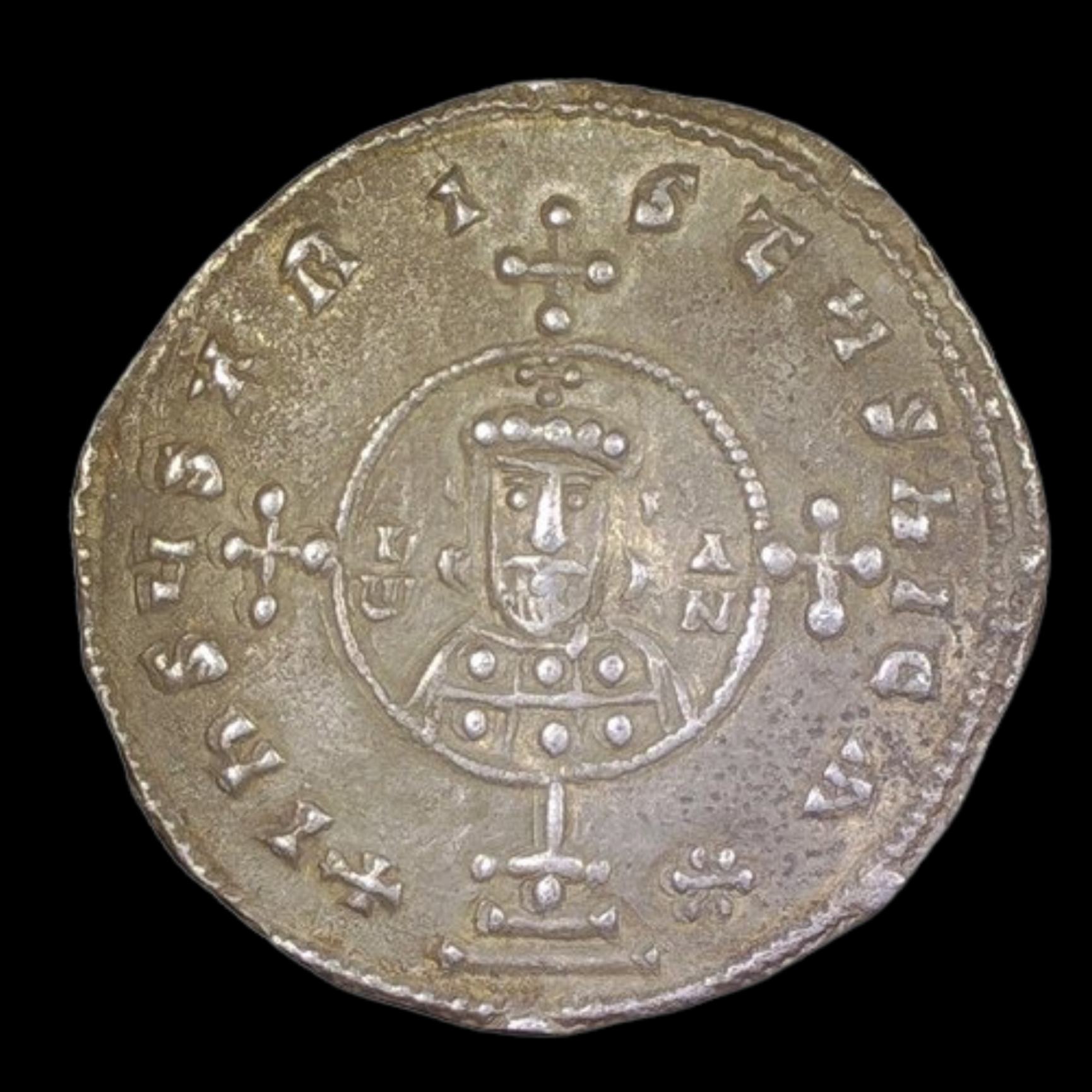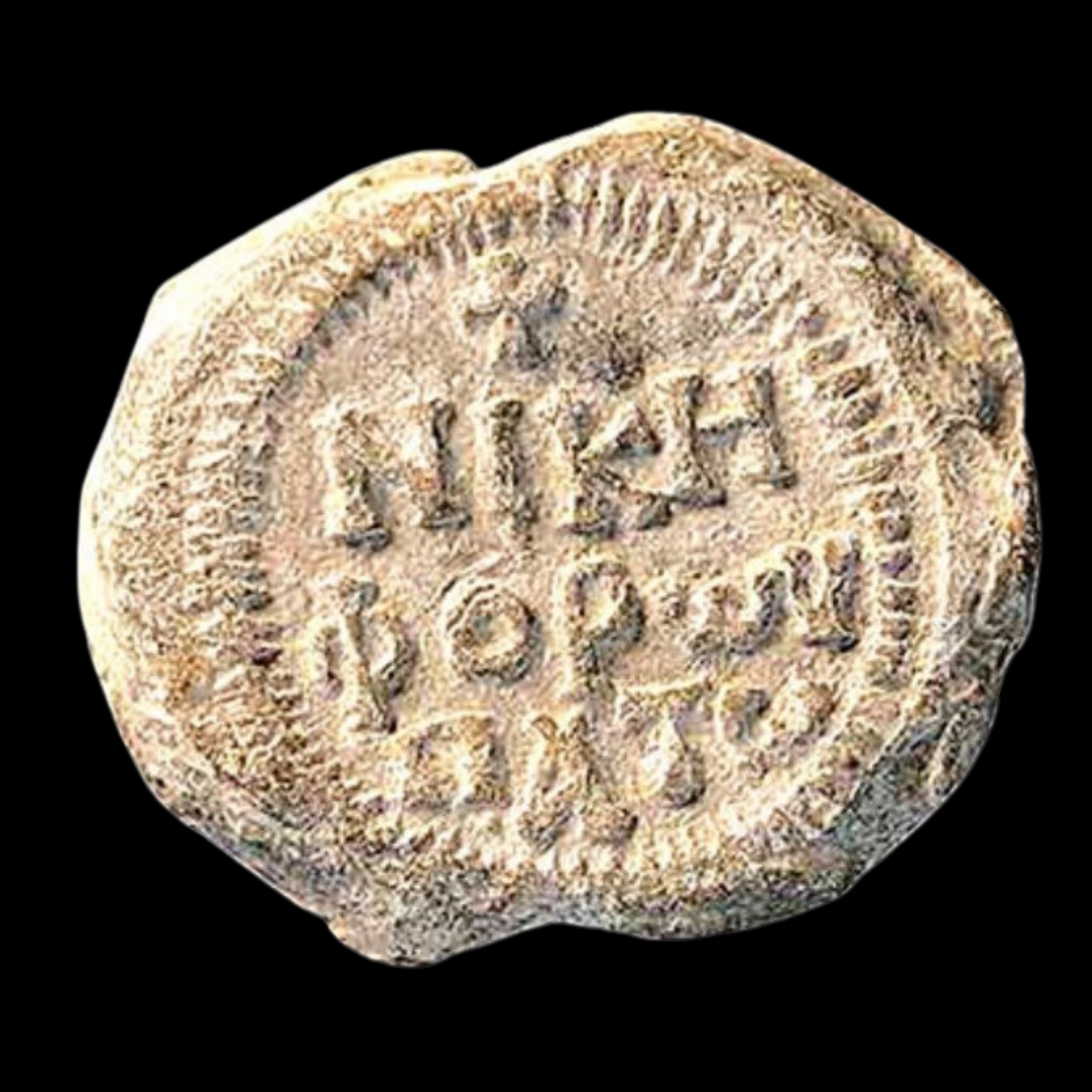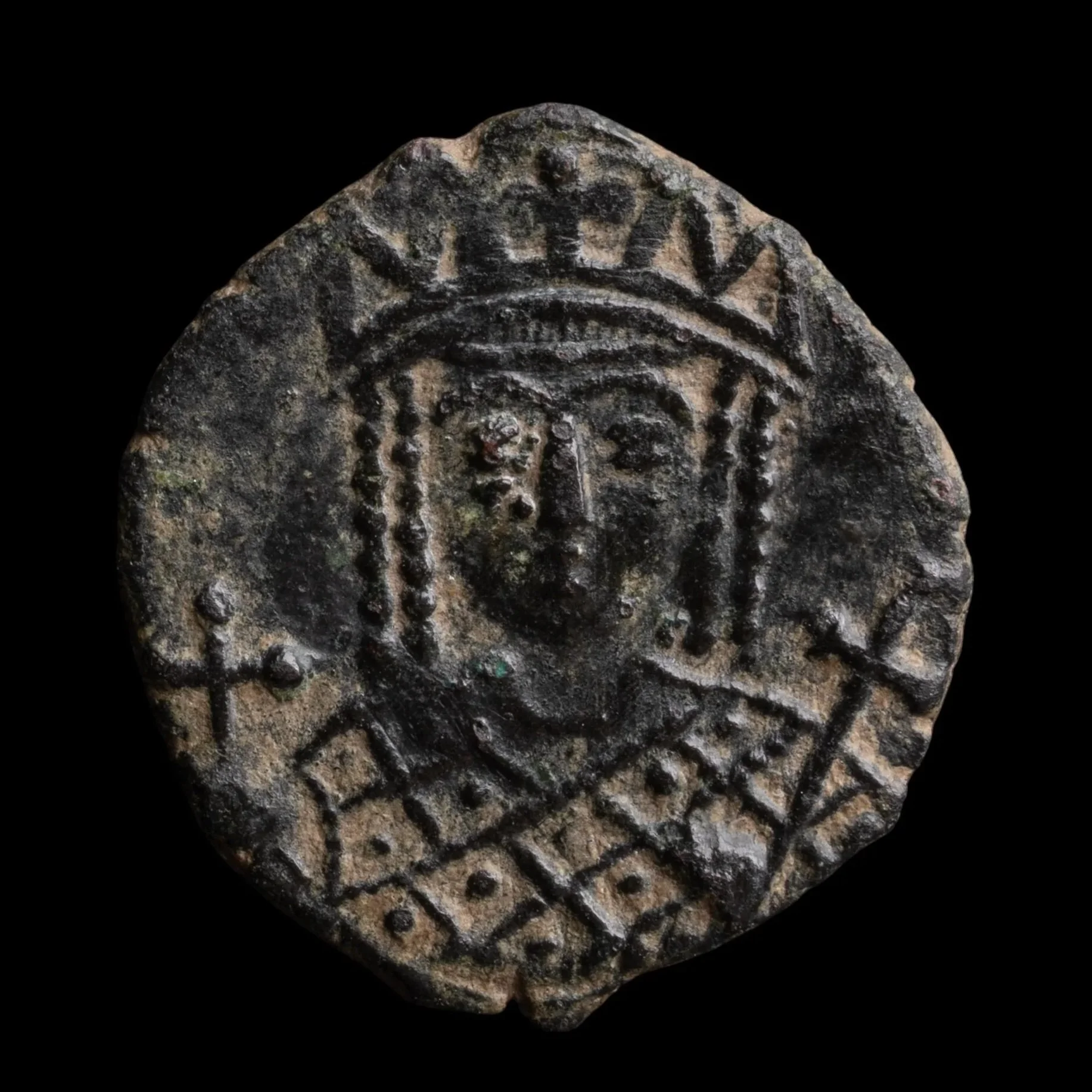 Image 1 of 2
Image 1 of 2

 Image 2 of 2
Image 2 of 2



Holy Wars Box: Six Coins Highlighting Famous Battles Between Christians and Muslims
This remarkable collection features six authentic coins that circulated during pivotal conflicts between Christian and Muslim powers across the centuries. Each coin provides a tangible connection to these historic confrontations that shaped the course of world history from the early Islamic conquests through the Crusades and beyond.
1. Byzantine Gold Solidus of Heraclius (about 1390 years ago)
This gold coin was minted during the reign of Byzantine Emperor Heraclius, who led Christian forces against the early Islamic expansion under the Rashidun Caliphate.
Coin Description:
Front side: Portrait of Emperor Heraclius and his son Heraclius Constantine wearing crowns and imperial regalia
Back side: Cross on steps (symbolizing Christianity's triumph) with Greek inscriptions
Technical Details:
Gold composition
Denomination: Solidus
Date: 629-632 AD
Historical Significance: This coin circulated during the Byzantine Empire's desperate struggle against the early Islamic expansion. Emperor Heraclius had previously defeated the Persian Sassanid Empire and recovered the True Cross, only to face the new threat of Arab Muslim armies. The Battle of Mu'tah (629 AD) marked one of the first military encounters between Byzantine Christians and the forces of the nascent Islamic state, foreshadowing centuries of conflict to come.
2. Umayyad Silver Dirham (about 1300 years ago)
This silver coin was struck during the Umayyad Caliphate's expansion into Spain, following their conquest of the Visigothic Christian kingdom.
Coin Description:
Front side: Central field with Islamic declaration of faith (Shahada) in Arabic script, surrounded by further inscriptions
Back side: Central field with religious text, mint name, and date according to the Islamic calendar
Technical Details:
Silver composition
Denomination: Dirham
Date: Circa 720-730 AD
Historical Significance: This coin was minted shortly after the decisive Battle of Guadalete (711 AD), where Muslim forces under Tariq ibn Ziyad defeated the Visigothic King Roderic, leading to the Islamic conquest of most of the Iberian Peninsula. This victory established Al-Andalus (Muslim Spain) which would last for nearly eight centuries until the final Christian reconquest in 1492, and represents one of the most consequential battles in European history.
3. Byzantine Bronze Follis of Romanos IV (about 950 years ago)
This bronze coin was issued by Byzantine Emperor Romanos IV Diogenes, who led Christian forces against the Seljuk Turks at the disastrous Battle of Manzikert.
Coin Description:
Front side: Christ enthroned or bust of Christ, with Greek inscriptions
Back side: Standing figure of Emperor Romanos IV in imperial regalia, holding a scepter and globe
Technical Details:
Bronze composition
Denomination: Follis
Date: 1068-1071 AD
Historical Significance: This coin was in circulation during Emperor Romanos IV's ill-fated campaign against the Seljuk Turks, which culminated in the catastrophic Battle of Manzikert (1071 AD). The emperor's defeat and capture by Sultan Alp Arslan opened Anatolia (modern Turkey) to Turkish settlement, eventually leading to the formation of the Ottoman Empire. Many historians consider Manzikert one of the decisive battles in history, beginning the transformation of Asia Minor from a Christian to a predominantly Muslim region.
4. Crusader Silver Denier of the Kingdom of Jerusalem (about 850 years ago)
This crude silver coin was minted in the Crusader Kingdom of Jerusalem, established after the First Crusade's successful capture of the Holy City.
Coin Description:
Front side: Cross with various symbols in quarters
Back side: Representation of the Church of the Holy Sepulchre or the Tower of David in Jerusalem
Technical Details:
Silver composition
Denomination: Denier (penny)
Date: Circa 1170-1180 AD
Historical Significance: This coin circulated in the Latin Kingdom of Jerusalem, established after Christian Crusaders captured Jerusalem in 1099 following Pope Urban II's call to reclaim the Holy Land. The coin represents the period between the Second and Third Crusades, when Christian control of Jerusalem was threatened by the rising power of Saladin, Sultan of Egypt and Syria. The subsequent Battle of Hattin (1187 AD) would result in Saladin's victory and the recapture of Jerusalem by Muslim forces.
5. Mamluk Gold Dinar of Sultan Qutuz (about 760 years ago)
This gold coin was issued by the Mamluk Sultan Qutuz, who led Muslim forces to a crucial victory against Mongol invaders at the Battle of Ain Jalut.
Coin Description:
Front side: Arabic inscriptions giving Sultan Qutuz's name and titles
Back side: Religious inscriptions, mint name, and date in Arabic script
Technical Details:
Gold composition
Denomination: Dinar
Date: 1259-1260 AD
Historical Significance: This coin was minted during the brief reign of Sultan Qutuz, who led Mamluk forces to victory against the previously undefeated Mongols at the Battle of Ain Jalut (1260 AD) in Galilee (modern Israel). While not directly fought against Christian forces, this battle saved both the Muslim world and indirectly protected European Christendom from further Mongol advances. The battle is considered pivotal in world history for stopping the seemingly unstoppable Mongol expansion and preserving Islamic civilization in the Middle East.
6. Spanish Silver 8 Reales of Philip II (about 450 years ago)
This large silver coin was minted under King Philip II of Spain, who organized the Holy League that defeated Ottoman Turkish forces at the naval Battle of Lepanto.
Coin Description:
Front side: Crowned shield of Spain displaying the arms of Castile, Leon, Aragon, and other Spanish territories
Back side: Cross of Jerusalem with the pillars of Hercules and banner "PLUS ULTRA" (Further Beyond)
Technical Details:
Silver composition
Denomination: 8 Reales (piece of eight)
Date: 1571-1575 AD
Historical Significance: This coin was minted shortly after the decisive naval Battle of Lepanto (October 7, 1571), where the Holy League fleet, organized by Pope Pius V and commanded by Don John of Austria, decisively defeated the Ottoman Turkish navy. Although the Ottoman Empire would rebuild its fleet, Lepanto shattered the myth of Ottoman naval invincibility and halted Turkish expansion in the Mediterranean. The battle is often celebrated as one of the most significant victories of Christian Europe against Ottoman power and inspired art, music, and literature across Europe.
This remarkable collection features six authentic coins that circulated during pivotal conflicts between Christian and Muslim powers across the centuries. Each coin provides a tangible connection to these historic confrontations that shaped the course of world history from the early Islamic conquests through the Crusades and beyond.
1. Byzantine Gold Solidus of Heraclius (about 1390 years ago)
This gold coin was minted during the reign of Byzantine Emperor Heraclius, who led Christian forces against the early Islamic expansion under the Rashidun Caliphate.
Coin Description:
Front side: Portrait of Emperor Heraclius and his son Heraclius Constantine wearing crowns and imperial regalia
Back side: Cross on steps (symbolizing Christianity's triumph) with Greek inscriptions
Technical Details:
Gold composition
Denomination: Solidus
Date: 629-632 AD
Historical Significance: This coin circulated during the Byzantine Empire's desperate struggle against the early Islamic expansion. Emperor Heraclius had previously defeated the Persian Sassanid Empire and recovered the True Cross, only to face the new threat of Arab Muslim armies. The Battle of Mu'tah (629 AD) marked one of the first military encounters between Byzantine Christians and the forces of the nascent Islamic state, foreshadowing centuries of conflict to come.
2. Umayyad Silver Dirham (about 1300 years ago)
This silver coin was struck during the Umayyad Caliphate's expansion into Spain, following their conquest of the Visigothic Christian kingdom.
Coin Description:
Front side: Central field with Islamic declaration of faith (Shahada) in Arabic script, surrounded by further inscriptions
Back side: Central field with religious text, mint name, and date according to the Islamic calendar
Technical Details:
Silver composition
Denomination: Dirham
Date: Circa 720-730 AD
Historical Significance: This coin was minted shortly after the decisive Battle of Guadalete (711 AD), where Muslim forces under Tariq ibn Ziyad defeated the Visigothic King Roderic, leading to the Islamic conquest of most of the Iberian Peninsula. This victory established Al-Andalus (Muslim Spain) which would last for nearly eight centuries until the final Christian reconquest in 1492, and represents one of the most consequential battles in European history.
3. Byzantine Bronze Follis of Romanos IV (about 950 years ago)
This bronze coin was issued by Byzantine Emperor Romanos IV Diogenes, who led Christian forces against the Seljuk Turks at the disastrous Battle of Manzikert.
Coin Description:
Front side: Christ enthroned or bust of Christ, with Greek inscriptions
Back side: Standing figure of Emperor Romanos IV in imperial regalia, holding a scepter and globe
Technical Details:
Bronze composition
Denomination: Follis
Date: 1068-1071 AD
Historical Significance: This coin was in circulation during Emperor Romanos IV's ill-fated campaign against the Seljuk Turks, which culminated in the catastrophic Battle of Manzikert (1071 AD). The emperor's defeat and capture by Sultan Alp Arslan opened Anatolia (modern Turkey) to Turkish settlement, eventually leading to the formation of the Ottoman Empire. Many historians consider Manzikert one of the decisive battles in history, beginning the transformation of Asia Minor from a Christian to a predominantly Muslim region.
4. Crusader Silver Denier of the Kingdom of Jerusalem (about 850 years ago)
This crude silver coin was minted in the Crusader Kingdom of Jerusalem, established after the First Crusade's successful capture of the Holy City.
Coin Description:
Front side: Cross with various symbols in quarters
Back side: Representation of the Church of the Holy Sepulchre or the Tower of David in Jerusalem
Technical Details:
Silver composition
Denomination: Denier (penny)
Date: Circa 1170-1180 AD
Historical Significance: This coin circulated in the Latin Kingdom of Jerusalem, established after Christian Crusaders captured Jerusalem in 1099 following Pope Urban II's call to reclaim the Holy Land. The coin represents the period between the Second and Third Crusades, when Christian control of Jerusalem was threatened by the rising power of Saladin, Sultan of Egypt and Syria. The subsequent Battle of Hattin (1187 AD) would result in Saladin's victory and the recapture of Jerusalem by Muslim forces.
5. Mamluk Gold Dinar of Sultan Qutuz (about 760 years ago)
This gold coin was issued by the Mamluk Sultan Qutuz, who led Muslim forces to a crucial victory against Mongol invaders at the Battle of Ain Jalut.
Coin Description:
Front side: Arabic inscriptions giving Sultan Qutuz's name and titles
Back side: Religious inscriptions, mint name, and date in Arabic script
Technical Details:
Gold composition
Denomination: Dinar
Date: 1259-1260 AD
Historical Significance: This coin was minted during the brief reign of Sultan Qutuz, who led Mamluk forces to victory against the previously undefeated Mongols at the Battle of Ain Jalut (1260 AD) in Galilee (modern Israel). While not directly fought against Christian forces, this battle saved both the Muslim world and indirectly protected European Christendom from further Mongol advances. The battle is considered pivotal in world history for stopping the seemingly unstoppable Mongol expansion and preserving Islamic civilization in the Middle East.
6. Spanish Silver 8 Reales of Philip II (about 450 years ago)
This large silver coin was minted under King Philip II of Spain, who organized the Holy League that defeated Ottoman Turkish forces at the naval Battle of Lepanto.
Coin Description:
Front side: Crowned shield of Spain displaying the arms of Castile, Leon, Aragon, and other Spanish territories
Back side: Cross of Jerusalem with the pillars of Hercules and banner "PLUS ULTRA" (Further Beyond)
Technical Details:
Silver composition
Denomination: 8 Reales (piece of eight)
Date: 1571-1575 AD
Historical Significance: This coin was minted shortly after the decisive naval Battle of Lepanto (October 7, 1571), where the Holy League fleet, organized by Pope Pius V and commanded by Don John of Austria, decisively defeated the Ottoman Turkish navy. Although the Ottoman Empire would rebuild its fleet, Lepanto shattered the myth of Ottoman naval invincibility and halted Turkish expansion in the Mediterranean. The battle is often celebrated as one of the most significant victories of Christian Europe against Ottoman power and inspired art, music, and literature across Europe.










